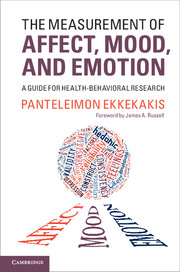Book contents
- Frontmatter
- Contents
- Figures
- Foreword
- Prologue
- 1 Documenting the breadth and depth of the problem
- 2 Untangling the terminological Gordian knot
- 3 Should affective states be considered as distinct entities or as positioned along dimensions?
- 4 Are pleasant and unpleasant states independent or polar opposites?
- 5 Selecting a measure
- 6 The old classics
- 7 Dimensional measures
- 8 Domain-specific measurement
- 9 Problems of domain specificity
- Epilogue
- References
- Index
7 - Dimensional measures
Published online by Cambridge University Press: 05 March 2013
- Frontmatter
- Contents
- Figures
- Foreword
- Prologue
- 1 Documenting the breadth and depth of the problem
- 2 Untangling the terminological Gordian knot
- 3 Should affective states be considered as distinct entities or as positioned along dimensions?
- 4 Are pleasant and unpleasant states independent or polar opposites?
- 5 Selecting a measure
- 6 The old classics
- 7 Dimensional measures
- 8 Domain-specific measurement
- 9 Problems of domain specificity
- Epilogue
- References
- Index
Summary
Dimensional models of core affect, mood, and emotions have maintained a prominent position in psychology for decades. Accordingly, such models have provided the conceptual foundation for the development of an array of measures (see Figure 7.1), some of which (like the Positive and Negative Affect Schedule) have been used in thousands of studies and some whose use is less widespread. For the former, the aim of this chapter is to highlight strengths and limitations that have become apparent through years of extensive use. For those in the latter category, the aim of the chapter is to bring them to the attention of researchers who may not be aware of them and to describe their basic features.
The Self-Assessment Manikin
The Self-Assessment Manikin (SAM) was developed by Lang (1980; Hodes et al., 1985) on the basis of Mehrabian and Russell’s (1974) three-dimensional model of “emotion” (which would now be considered a model of core affect). The three dimensions of the model, which were theorized to be bipolar and orthogonal, were pleasure-displeasure, arousal-nonarousal, and dominance-submissiveness (also referred to as potency, self-efficacy, or control). Accordingly, the Self-Assessment Manikin consisted of scales measuring each of these three dimensions. The Self-Assessment Manikin is unique in that each scale consists of a series of cartoon-like characters with expressions ranging from happiness (smiling face) to sadness (frowning face), from sleepiness (eyes closed) to high arousal (shaking and heart pounding), and from submissiveness (small size) to dominance (large size). The original version of the Self-Assessment Manikin was computer based. Users could manipulate the expressions interactively through a series of 30 progressively different images using a joystick.
- Type
- Chapter
- Information
- The Measurement of Affect, Mood, and EmotionA Guide for Health-Behavioral Research, pp. 121 - 137Publisher: Cambridge University PressPrint publication year: 2013
- 1
- Cited by



